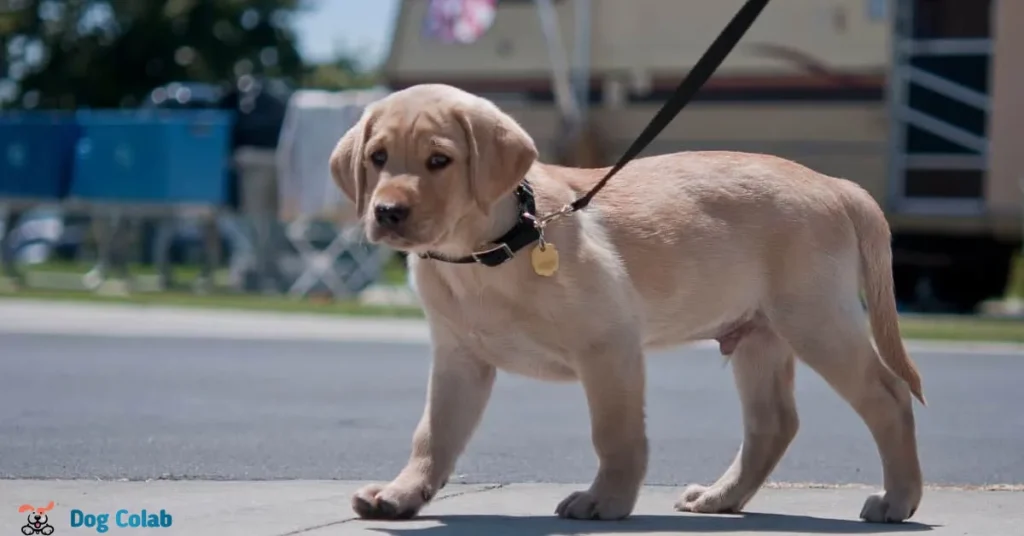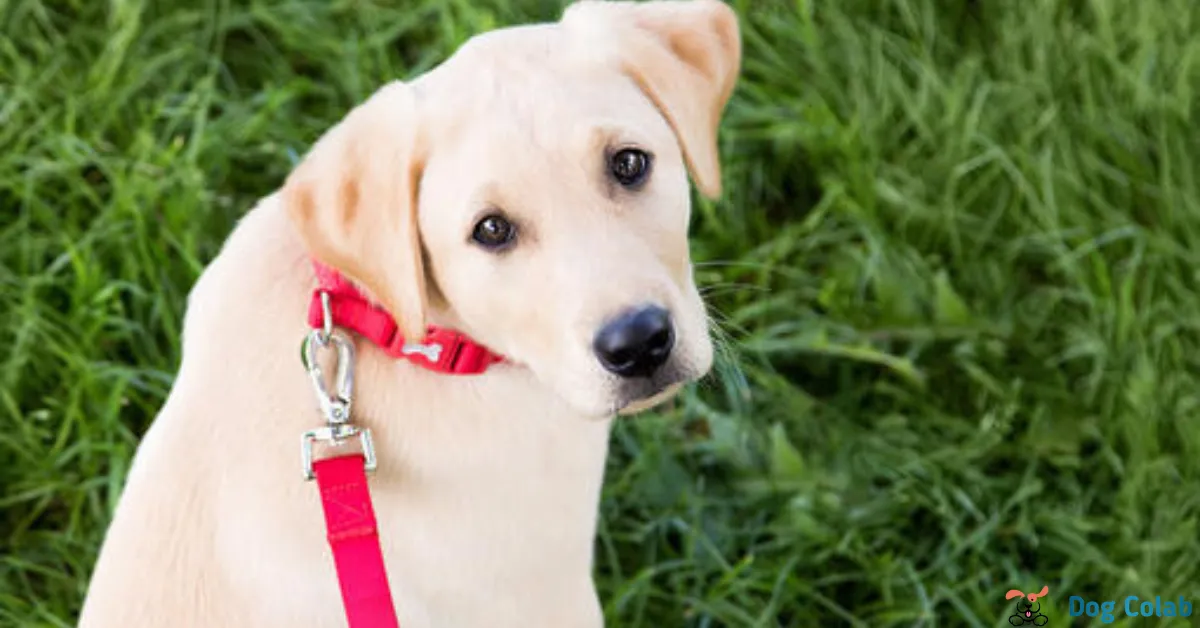Bringing home a new puppy is an exciting and joyous experience for any pet owner. As part of responsible pet ownership, it is essential to introduce your puppy to essential accessories, such as a collar. While some puppies may take to wearing a collar easily, others may require more time and patience to get used to it.
So, In this blog post, we will discuss how long does it take for a puppy to get used to a collar, providing valuable tips and guidance to ensure a smooth and stress-free transition.
Is It Ok For Puppy To Wear Collar?
Yes, it is generally okay for a puppy to wear a collar, but there are some important considerations to keep in mind. Introducing a collar to a puppy at a young age is beneficial for various reasons, such as identification purposes, leash training, and ensuring their safety during outdoor activities.

However, it is crucial to use a lightweight, well-fitted collar that does not cause discomfort or restrict the puppy’s movement.
What Age To Put Collar On Puppy?
It is generally recommended to start introducing a collar to a puppy at around 8 to 10 weeks of age. This is the age when most puppies are being adopted or brought into their new homes. Starting early allows the puppy to get used to wearing a collar and associating it with positive experiences from an early stage.

However, it is essential to use a lightweight, adjustable collar that fits the puppy comfortably and does not cause any discomfort or restriction. As the puppy grows, regularly check the collar’s fit and adjust it accordingly to ensure it remains comfortable and secure.
Recommended Also Read:- Put the collar on dogs that bite.
Puppy Collars: What Type Is Best?
Choosing the right type of collar for a puppy is essential to ensure their safety, comfort, and successful acclimation. Several types of collars are available, each with its own benefits and considerations. The best collar for a puppy will depend on their age, breed, size, and individual needs.

Here are some common collar types suitable for puppies.
1. Flat Buckle Collar
This type of collar is a classic choice for puppies. It has a buckle closure, which allows for easy adjustment and a secure fit. Choose a flat collar made from soft, lightweight materials to minimize any discomfort for your puppy.
2. Breakaway Collar
Breakaway collars are designed to release if the puppy’s collar gets caught on something, reducing the risk of injury or strangulation. They are a good option for puppies that spend time outdoors unsupervised or in environments with potential hazards.
3. Quick-Release Collar
Similar to breakaway collars, quick-release collars have a buckle that easily opens with a press of a button. This type of collar is suitable for puppies that are still learning to walk on a leash, as it allows for a quick release in case of emergencies.
4. Martingale Collar
Martingale collars are designed to provide more control without choking the puppy. They are particularly useful for puppies that tend to slip out of traditional flat collars, such as sight hounds or dogs with narrow heads.
5. Harness
While not technically a collar, harnesses can be an excellent alternative for leash-training puppies. They distribute pressure evenly across the chest and back, reducing strain on the neck and trachea. Harnesses are especially beneficial for small or brachycephalic breeds prone to respiratory issues.
6. Personalized or Adjustable Collar
Consider getting a collar that is adjustable and can grow with your puppy. Additionally, you can opt for personalized collars with the puppy’s name and your contact information embroidered or printed on them, enhancing their identification.
Regardless of the type of collar you choose, ensure that it is the right size for your puppy and fits comfortably without causing any chafing or constriction. Regularly check the fit of the collar as your puppy grows and adjust it accordingly. Always supervise your puppy when they wear the collar, especially during the acclimation period.
Recommended Also Read:- Are martingale collars good for dogs.
How To Get Your Puppy Used To A Collar?
Getting your puppy used to a collar requires a gradual and positive approach. Here’s a step-by-step guide to help you acclimate your puppy to wearing a collar:

- Start Early: Begin introducing the collar as soon as you bring your puppy home, ideally at around 8 to 10 weeks of age. Younger puppies tend to adapt more easily to new experiences.
- Choose the Right Collar: Select a lightweight and comfortable collar made of soft materials. Avoid collars with rough edges or heavy adornments that might cause discomfort.
- Show and Sniff: Allow your puppy to investigate the collar first without putting it on. Hold the collar near your puppy, and let them sniff and interact with it. This helps familiarize them with the collar’s scent and presence.
- Positive Reinforcement: Use treats, toys, and verbal praise to create a positive association with the collar. Reward your puppy whenever they show interest in or approach the collar. This will help them associate the collar with something enjoyable.
- Short Intervals: Begin by putting the collar on your puppy for short periods, such as a few minutes at a time. As your puppy becomes more comfortable, gradually increase the duration. Be present during this time to monitor their reaction.
- Distractions and Play: Engage your puppy in play or fun activities while they wear the collar. This will help divert their attention from the collar and make the experience more enjoyable.
- Consistency: Be consistent with the collar-wearing routine. Avoid taking the collar off and putting it back on frequently, as this can confuse your puppy. The collar should become a regular part of their day.
- Supervised Playtime: During the initial stages of acclimation, keep your puppy under supervision while they wear the collar. This will prevent them from scratching, pawing, or getting entangled in the collar.
- Comfortable Fit: Ensure the collar is properly fitted and not too tight or too loose. A well-fitted collar should allow you to fit two fingers comfortably between the collar and your puppy’s neck.
- Stay Patient: Be patient and stay calm throughout the process. If your puppy shows resistance or discomfort, take a step back and try again later. Forcing the collar on your puppy may create negative associations.
- Remove During Rest and Sleep: Initially, it’s a good idea to remove the collar during rest and sleep to give your puppy a break. However, remember to put it back on during waking hours.
- Celebrate Success: Celebrate each small success. Reward and praise your puppy whenever they wear the collar without any issues. This positive reinforcement will reinforce their acceptance of the collar.
By following these steps and being patient with your puppy, they should gradually get used to wearing a collar. Remember that every puppy is unique, and the time it takes to acclimate them may vary. Make the experience as positive and enjoyable as possible, and soon your puppy will be confidently wearing their collar.
You may also be interested in:- Should dogs wear the collar all the time.
How Long Does It Take For A Puppy To Get Used To A Collar?
The time it takes for a puppy to get used to wearing a collar can vary depending on the individual puppy’s temperament, age, and previous experiences. Some puppies may adjust to wearing a collar relatively quickly, while others may take more time and patience. Generally, the acclimation process can take anywhere from a few days to a couple of weeks.

The key to successful collar acclimation is to take a gradual and positive approach. Start by introducing the collar for short periods and gradually increase the duration as your puppy becomes more comfortable. Using positive reinforcement, such as treats and praise, can also help create a positive association with the collar.
During the process, closely observe your puppy’s behavior for any signs of discomfort or stress. If your puppy seems agitated or resistant, it’s essential to be patient and avoid forcing the collar. Instead, take a step back and try again later or make adjustments, such as using a different type of collar or introducing more positive reinforcement.
Remember that each puppy is unique, and some may need more time to adapt to wearing a collar than others. The key is to be patient, consistent, and understanding during the acclimation process. With time and positive reinforcement, most puppies should eventually become comfortable wearing their collars.
Conclusion “How Long Does It Take For A Puppy To Get Used To A Collar”
The duration it takes for a puppy to get used to wearing a collar varies from one pup to another, influenced by factors such as age, breed, personality, and previous experiences.
The key to successful acclimation is to take a gentle and positive approach, using consistent training methods and offering positive reinforcement. With time and understanding, most puppies will eventually grow comfortable and confident wearing their collars.
NOTE:- More information can be found by clicking this link.
FAQs
1. Should puppies wear collars at night?
It’s generally recommended to remove a puppy’s collar at night. This allows their neck to rest and reduces the risk of accidents or injuries associated with wearing a collar continuously.
2. Is it safe to walk a puppy with a collar?
No, it is not safe to walk a puppy with a collar, especially if they have spine, neck, or breathing issues, or belong to toy or brachycephalic breeds like Chihuahuas, Pugs, or Bulldogs. A harness would be a better choice.
3. Do collars bother puppies?
Yes, collars can bother puppies initially as they are not used to wearing them. They may exhibit normal behaviors like biting, scratching, or refusing to walk, but with proper training, most puppies can adjust to wearing collars within a week.
4. Why do puppies hate collars?
Puppies might dislike collars initially due to unfamiliarity and discomfort. The feeling of something around their neck can be strange and restrictive. Proper collar introduction, gradual wear, and positive reinforcement can help them acclimate and view collars positively.

